Improving Community Safety with the Rideau River Multi-Use Pathway
An exciting transformation has taken place at Bank Street and Riverside Drive in Ottawa. The multi-use pathway below Billings Bridge makes it safer and easier for bikes, pedestrians and motorized vehicles to move through one of the busiest intersections in the Nation’s Capital.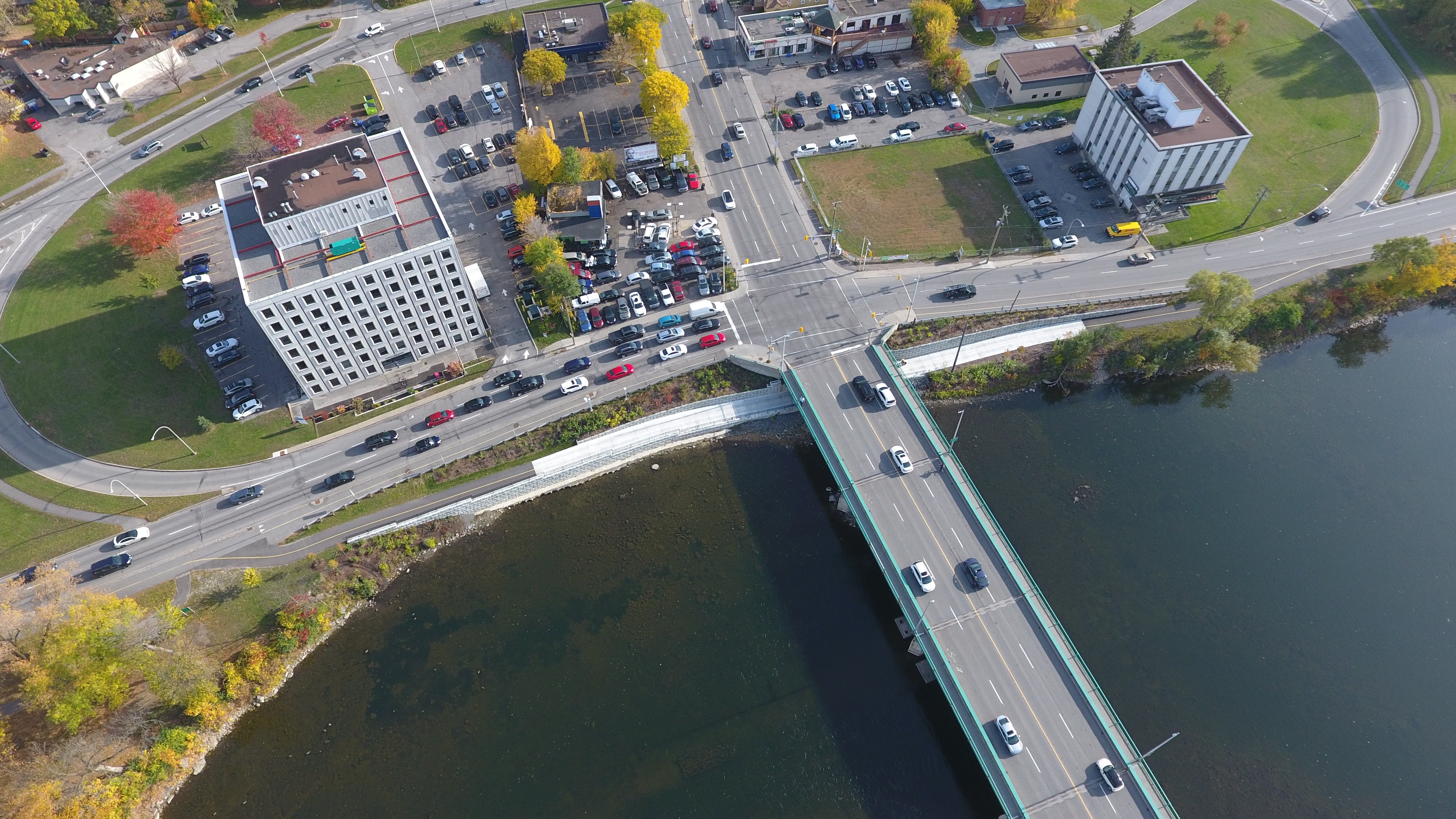
Building a multi-use pathway is relatively straight forward, under normal circumstances. But throw in a host of challenges like land constraints, environmental sensitivities, restrictive scheduling and meeting the approvals of multiple regulators, and the level of complexity increases significantly.
Ottawa: An Active Transportation Hub
The Nation’s Capital is home to some of the most forward-thinking and extensive cycling infrastructure in the province, with a growing network of bridges, pathways and cycling tracks. There are over 600 km of multi-use pathways linking natural areas, parks and attractions and providing an option to those choosing alternative methods of transportation for their daily commutes. Billings Bridge has long been a problem area for cyclists and pedestrians. Users of the Rideau River Eastern Pathway, the multi-use path along Riverside Drive, had to cross Bank Street at a very busy intersection at the south end of Billings Bridge. The large volume of traffic crossing the bridge, including a large number of vehicles turning onto Riverside Drive, made for a very dangerous situation with a high potential for conflicts, earning this location a reputation as one of the worst intersections in the city for pedestrians and cyclists.
The Need for a Safer Option in the Community
In 2013, the unthinkable happened. A cyclist was struck and killed by a truck at this location while cycling home. In response to the increasing community concerns for pedestrian and cyclist safety, the National Capital Commission (NCC) identified this and two other sites as priority locations to modify existing facilities and make improvements for active transportation users. When funding became available through the Public Transit Infrastructure Fund, the NCC and the City of Ottawa joined forces with Morrison Hershfield to improve safety for vulnerable users of the Rideau River Eastern Pathway at Billings Bridge.
Designing a Solution
Design began in 2017, when Morrison Hershfield provided engineering design and 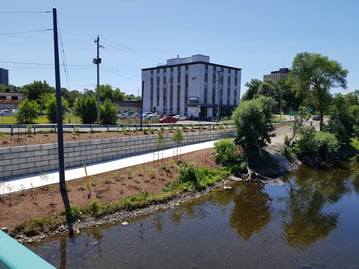 tendering services for the new grade separated pathway, along with construction administration, inspection and engineering support services during construction. The firm worked closely with clients, multiple stakeholders and the public to develop a design that maximizes pedestrian and cyclist safety and minimizes vehicular disruption at this high volume intersection. Numerous design iterations were developed and presented to the NCC during the preliminary and detailed design phases, and all presented a grade separated pathway since the existing intersection configuration did not allow the opportunity to upgrade the at-grade crossing itself. The preferred solution was a grade-separated multi-use pathway below Bank Street, adjacent to the abutment along the eastern shore of the Rideau River.
tendering services for the new grade separated pathway, along with construction administration, inspection and engineering support services during construction. The firm worked closely with clients, multiple stakeholders and the public to develop a design that maximizes pedestrian and cyclist safety and minimizes vehicular disruption at this high volume intersection. Numerous design iterations were developed and presented to the NCC during the preliminary and detailed design phases, and all presented a grade separated pathway since the existing intersection configuration did not allow the opportunity to upgrade the at-grade crossing itself. The preferred solution was a grade-separated multi-use pathway below Bank Street, adjacent to the abutment along the eastern shore of the Rideau River.
Detail design for the enhanced pathway began in May 2017. Over the course of the project, extensive coordination was required due to the sensitive project location. A large number of federal and provincial permitting agencies were involved, including Department of Fisheries and Oceans Canada, Environment Canada and Climate Change, Ministry of Natural Resources and Forestry, Rideau Valley Conservation Authority and Transport Canada. All permits were in place before official construction began in September 2018. There were also numerous local interest groups whose concerns were taken into account throughout the study.
Completed in July 2019, the Rideau River – Bank Street Multi-Use Pathway is a new 200 metre long, three metre wide grade-separated pathway that runs under the Billings Bridge, along the eastern shore of the Rideau River. The pathway provides cyclists and pedestrians safe and continuous access to the Rideau River Eastern Pathway network. The pathway contains three large concrete block retaining walls with limestone face texture. The retaining wall was needed due to the three metre elevation difference between the Rideau River and Riverside Drive, and the limestone face texture added the desired aesthetic. Concrete block walls were chosen over armour stone because the blocks are easier to install (they fit together like Lego pieces) and maintain. NCC preferred the look of natural stone, hence the limestone face texture. The pathway and retaining wall designs are strong enough to withstand periodic flooding and ice scour during the winter months. Steps were taken to minimize any impacts on the Rideau River.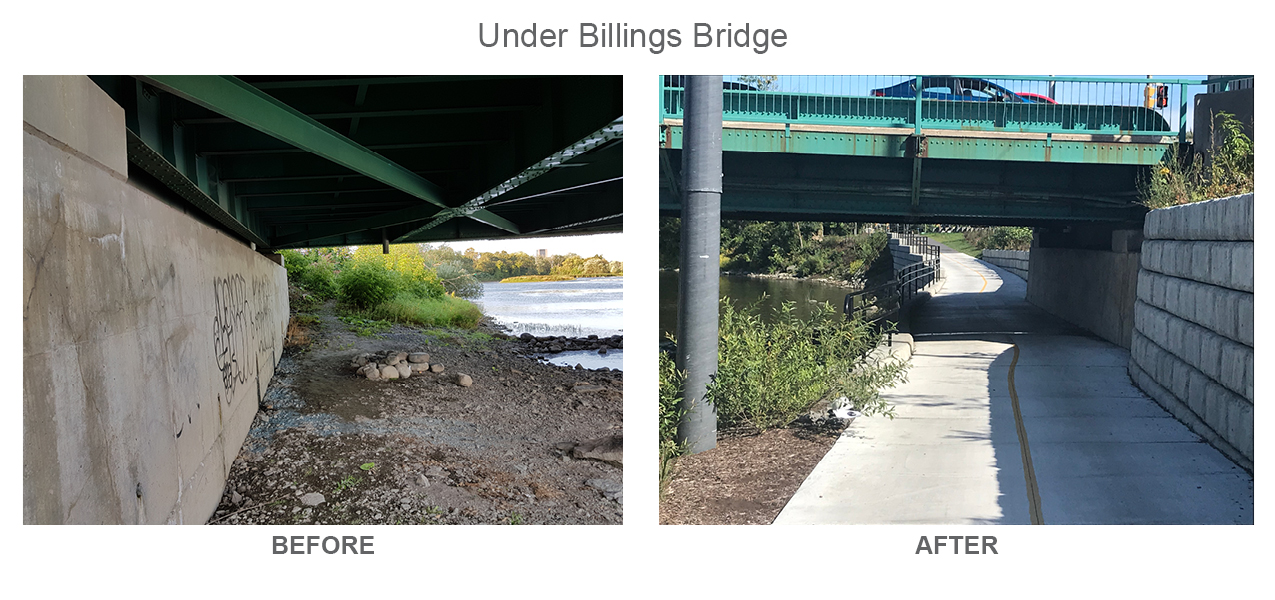
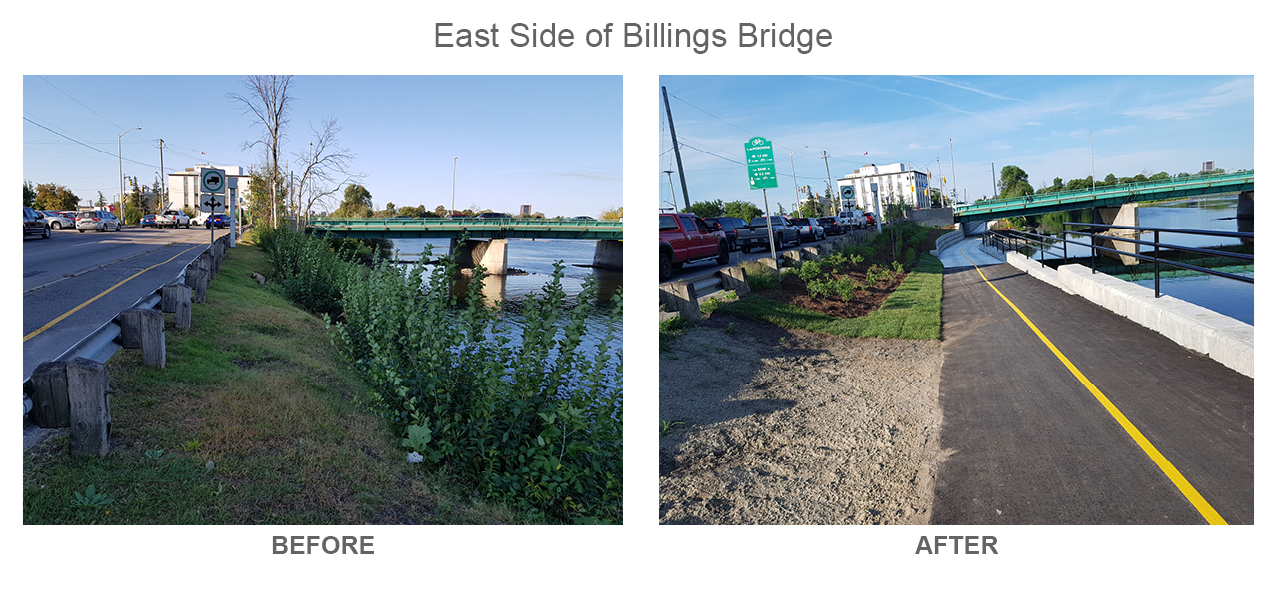
Innovative Choices to Overcome Design Challenges
The Rideau River is prone to flooding, especially during large summer storms or spring thaw. Because a section of new pathway is below the Rideau River two-year high water mark, that portion of the pathway is constructed with concrete to prevent degradation due to such flooding events. Above the two-year high water mark, the pathway is asphalt.
Due to the three metre grade elevation separation between the Rideau River and Riverside Drive, Redi- Rock concrete blocks were used to construct the retaining walls on site. These blocks are relatively easy to install (rapid placement) and limit the encroachment of the embankment into the Rideau River. A limestone texture facing was chosen to maintain as close to natural stone look as possible. The walls are designed to withstand flooding as well as heavy yearly winter ice flows.
A pedestrian handrail runs along the full length of the retaining wall located immediately adjacent the Rideau River. It was designed to provide added safety and maintain the scenic views of the River without being visually obtrusive.
The landscape design, consisting of numerous trees and small shrubs, ties into the natural surroundings, and blends with the natural beauty of the Rideau River corridor. Native plant species were used. Wetland restoration was necessary to repair the impact of constructing the retaining wall and pathway. Landscaping and restoration were carried out by the Contractor per the detailed plans provided by Morrison Hershfield.
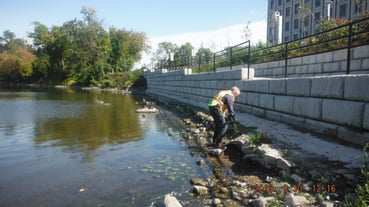
The project was situated on both federal and provincially owned land. This meant obtaining all necessary permits for Federal Land Use as well as meeting provincial requirements. To obtain all the necessary permits and permissions from environmental agencies, Morrison Hershfield successfully demonstrated that construction would have little to no impact on the Rideau River, including Species at Risk (birds, fish or turtles), water levels of the river and marine traffic, and that proper mitigation measures would be put in place during construction to prevent any potential impacts. Careful coordination with the Contractor and the City was essential for the timely resolution of unexpected site issues during construction and to minimize impacts to the overall schedule.
Making a Difference Today
It's been one year since the completion of the grade separated multi-use pathway portion of the Eastern Rideau River Pathway at Billings Bridge. It has vastly improved safety for cyclists and pedestrians travelling east and west bound along the river. They can now completely avoid the busy intersection of Bank Street and Riverside Drive. The project also enhanced the natural beauty of the surrounding area, using a variety of landscape plantings and a custom retaining wall face texture.
This new pathway, though small in scale, has made an enormous difference in the lives of people using the city’s pathway network. The enhanced safety of the network has made it more attractive for users to choose alternative transportation methods which will ultimately reduce the number of motorized vehicles on the road, reducing greenhouse gas emissions and Ottawa’s overall carbon footprint. A safe and integrated active transportation network also promotes a healthy lifestyle by encouraging more people to use the network for recreation and exercise.
Capital Ward Councillor Shawn Menard summed up the importance of this new grade-separated link, stating: “This new MUP (multi-use pathway) is an important step in bringing some much-needed safety to the intersection of Bank and Riverside. The new underpass will be a welcome addition to the network of paths throughout the city. These paths help connect residents and communities, giving people added mobility while letting them enjoy some of the city’s beautiful greenspace.”
Green cities depend on sustainable transportation, but the networks must be safe, secure and inviting to users. Establishing a safe and sustainable multi-use pathway network helps to establish the Nation’s Capital as a world class cycling city.
Posts by Topic
Topics
- 5G (1)
- ACEC (3)
- Active Transportation (5)
- AFP/P3 (6)
- Alberta (5)
- Anniversary (1)
- approvals (1)
- Architect (2)
- Atlanta (2)
- Awards (62)
- Biophysical Sciences (1)
- Board of Directors (1)
- Bridge Rehabilitation (3)
- Building and Facilities Engineering (2)
- Building Energy (25)
- Building Envelope (48)
- Building Science (65)
- Calgary (2)
- Canada 150 (1)
- Canstruction (2)
- Capabilities (1)
- Carbon emissions (2)
- Carbon Pathfinder Tool (1)
- Carson Awards (5)
- Charity (13)
- Climate Adaption (7)
- climate change (7)
- Code and Life Safety (8)
- Commercial Buildings (4)
- Commissioning (11)
- Construction (2)
- Construction Administration (5)
- Consulting Engineering (1)
- Critical Facilities (33)
- CSR (24)
- Culture (5)
- Dallas (1)
- Data Center (22)
- Data Center Commissioning (9)
- Data Center Design (12)
- design (9)
- Design Build (1)
- DSSP (1)
- edgecomputing (1)
- edgetechnologies (1)
- Edmonton (4)
- Electrical (24)
- Electrical engineering (8)
- Energy (8)
- Engineers Canada (5)
- Environmental (36)
- Environmental Compensation (1)
- Environmental Impact Assessment (3)
- environmental planner (3)
- Environmental Planning (5)
- ETFE (1)
- Event (12)
- Existing Buildings (6)
- Facade Engineering (4)
- Ferry Docks (2)
- FIDIC (3)
- fisheries biologist (1)
- Flood Mapping (1)
- Florida (1)
- Forensic Investigation (1)
- Fundraising (11)
- garage (2)
- Gender Diversity (8)
- Gender Intelligence (3)
- Geometric Design (2)
- Government (14)
- Hospitality (1)
- Houston (4)
- Hydro (2)
- India (1)
- industrial (4)
- Infrastructure (28)
- Innovation (1)
- interchange (1)
- IWD (2)
- IWD2021 (1)
- Land Development (8)
- Landfill (4)
- Manitoba (1)
- MCF (3)
- Mechanical (21)
- Mechanical Engineering (1)
- MEP (1)
- mission critical (10)
- Moncton (1)
- Motivational MH'er (1)
- Multi-Use Pathways (1)
- Municipal Infrastructure (5)
- municipal solid waste (2)
- MUP (1)
- New Brunswick (1)
- New Hire (17)
- New Role (3)
- Newsroom (121)
- northern communities (2)
- NVTC (2)
- ontario (1)
- Operations Consulting (8)
- Ottawa (2)
- Panel (3)
- People (124)
- Project Management (6)
- QAP (1)
- Rail (1)
- Reconstruction (1)
- regulatory (1)
- Renewable Energy (2)
- resiliency (3)
- Risk Management (1)
- Roads and Highways (3)
- Salt Lake City (1)
- Seattle (1)
- Security (4)
- Social Responsibility (30)
- Solid Waste (11)
- solid waste management (5)
- St Johns (2)
- Stantec (1)
- Structural (14)
- Sustainability (23)
- Telecom (9)
- Texas (1)
- Toronto (13)
- towers (1)
- Traffic Assessment (2)
- Transfer Station (1)
- Transit (13)
- Transit Consultant (3)
- Transit Infrastructure (3)
- Transit Planning (2)
- Transportation (30)
- Transportation Engineering (8)
- transportation structures (2)
- TTC (1)
- Vancouver (6)
- Virginia (2)
- Washington DC (3)
- Waste to Energy (2)
- Water & Wastewater (8)
- Water Resources (3)
- wellfield (1)
- wellness challenge (1)
- Whistler (1)
- Whitehorse (1)
- Wireless (2)
- Women in Engineering (5)
- Yukon (5)